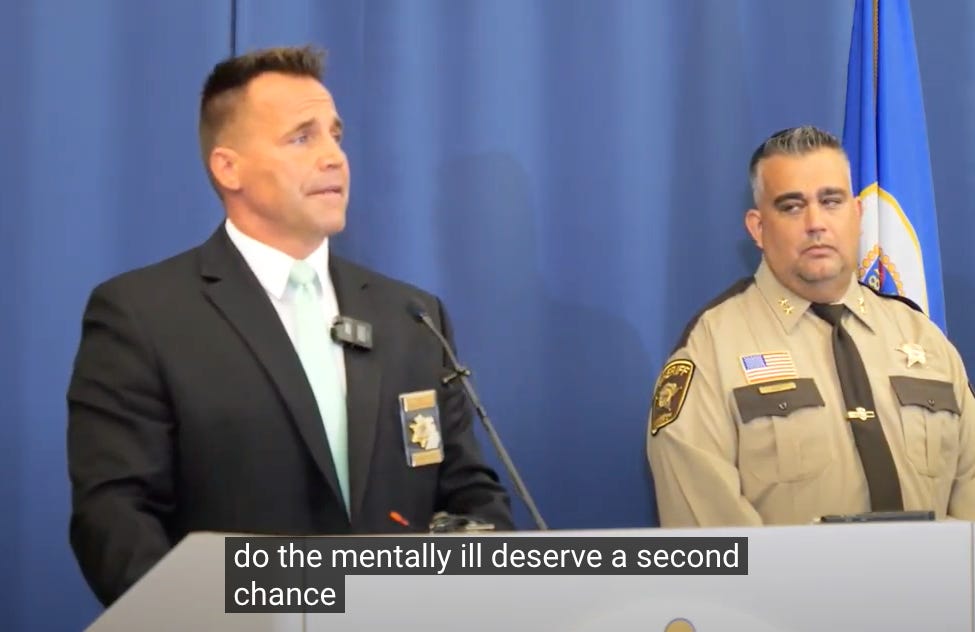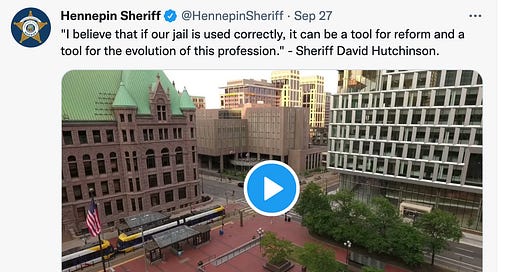Last week, the Hennepin County Sheriff’s Office released a video to promote their HOPE (Helping Others by Providing Education) program, which will provide “rigorous and robust education and training options for inmates at the Hennepin County Adult Detention Facility.” According to a news article, the classes include GED classes as well as “life skills” and vocational training. (It’s inspired by a similar program in Genesee County, Michigan called IGNITE.)

The goal appears noble. The Hennepin County jail will provide education and training that the sheriff says will continue after the person is released into the community. The program will work with for-profit and non-profit community partners. The whole project seems designed to benefit others; it’s in line with progressive ideals and notions of helping people become more productive and, according to the design, will have a positive impact by reducing recidivism.
At the same time, there’s a serious cognitive dissonance in having jails become more entrenched in people’s lives under the guise of progressive change. The reality is that the Hennepin County jail is has continued to incarcerate lots of people. While populations dropped at the height of the pandemic, the latest data suggests that numbers are back up. And, while Hennepin County overall is about 15% Black per the latest figures I found, nearly everyone depicted in this promotional video as a person in custody is a Black man.
Note: I assume that the jail’s population is disproportionately Black, but I couldn’t find very good stats. Per Vera, statewide, Black and Native American people are over-represented in Minnesota jails overall. Amy Klobuchar made a comment at some point that the racial disparity has grown less vast, but it’s still disproportionate.
Plus, it’s not as though the Hennepin County Jail has no other problems. It’s perpetually overcrowded, so much so that the prior sheriff submitted to a long audit. A year ago, Naajikhan Powell went directly from a medical facility, where he was for a mental health crisis, to the jail for an alleged outstanding warrant for refusing to take medication, according to Powell’s family. In jail, Powell died by suicide even though deputies should have been aware of his condition. (Plus, WHY WAS HE THERE? What earthly purpose was jail supposed to serve in this case?) Records showed that there have been 10 deaths since 2015 in that jail; three were under the current sheriff Hutchinson. When asked about Powell, Hutchinson refused to comment. But, he did get $20 million in COVID relief money to expand mental health services in his jail.
Jails are designed to hold people either pretrial or during court proceedings; they were never really designed to house people for long periods of time. (They were, often, designed to remove people from public spaces temporarily. Back in the day, it was common just to jail people for public intoxication on weekend nights, assuming that by the time they were released the next day, sober, they had been prevented from commiting a crime. ) So, how did they become a site for providing services? And why do sheriffs think that they are well-suited, even preferred, for this job?
The current Hennepin County sheriff Dave Hutchinson was elected in 2018 and ran on a reform-minded platform. One of his promises was to sever connections with ICE; based on that promise, he said he would limit his cooperation with immigration detainers. In fact, one news story presents Hutchinson’s decision as different from that of surrounding sheriffs, one of whom called theoretical people who might be deported “very tough customers.”
In contrast, Hutchinson talks about encouraging people to report crime and striving to work with community groups (even if his policies don’t go far enough). Hutchinson says he was required to comply with ICE directives in order to keep federal funding under a particular program that the prior sheriff had entered into, but he has asked to be judged by his intent not to comply with ICE deportations (which feels a little shady, but okay).
In this light, the HOME program seems to be something that Hennepin County residents would favor. At the same time, the county is also looking to invest more money into the jail to provide mental health treatment, and the sheriff has effectively avoided oversight for jail deaths, presumably because of his intent to do better.
So, in other words, Hutchinson is the kind of guy nice liberals want as sheriff, and he is doing nice liberal-people things. What’s the issue, you might ask?
Well, for one thing, why put more money into a county jail, which, if the county were so progressive, shouldn’t hold many people at all? Part of the problem is well-intended criminal system reform. As states strove to reduce their prison populations – prisons being places where people are held to serve their court-mandated confinement which can be anywhere from a year to a lifetime – county jails expanded. The financial costs to build, maintain, and staff large warehouses of people shifted from state governments to local ones (as did the liabilities when such places inevitably violate individual rights and fail to provide Constitutionally adequate services). The shifting of costs gave sheriffs more power in such progressive-minded schemes where they could claim more funding for presumably progressive-sounding ideas.
And Minnesota has also undergone state-wide reforms and shifting of incarcerated populations from state prisons to jails, just like most other states across the country. Vera’s data indicates that the state prison population has leveled off while jail admissions throughout the state continue to rise, especially in more rural regions. (Even still the total number of incarcerated people in the state has grown exponentially since the 1980s.)
It’s also useful to look at the specific history of the county, which has a history of thinking of itself as more progressive than it really is. Minneapolis (which is in Hennepin County) has been the epicenter of protests against police brutality since Derek Chauvin killed George Floyd last summer. It voted 70% for Joe Biden. City leaders considered a plan to reduce police funding and create a new department of public safety, which is generating a lot of opposition. At the same time, the city has not stopped arresting protestors. Sheriff Hutchinson himself spread the flames of “outside agitators” who were “rioting.” Hutchinson’s office provided additional policing for ongoing demonstrations, and the sheriff himself criticized city leaders who, he said, were “slow to realize the magnitude of the protesting, and how quickly it got out of hand.” Protestors who were arrested say they endured horrific and gross conditions at the jail (called a “public safety facility”) once they were taken into custody, where they could be legally caged for 36 hours without being charged. There were blood and feces on the wall. Transgender protestors were treated horrifically. Most cases were dropped.
As jails became “service providers,” the lack of services in society become more pronounced. Health experts pretty much all agree that care should be provided outside of the carceral context, in community settings. People benefit from the support of society and decompensate when they are isolated, mistreated, and neglected in jails. Yet, despite this health-minded consensus, we also have county sheriffs claiming to be creating new rehabilitative spaces that are simply dressing up the same carceral structures they already operate within.
It’s ridiculous when you think about it. Jail facilities, designed with security in mind, are taking care of people who need the most amount of care. In his book Progressive Punishment, Judah Schept discusses the contradictions and inherent clash when a local community and political figures envision that they can implement carceral policies in a positive way. In other words, while mass incarceration is a crisis in America, and the criminal system is cruel and punitive, the people in this county – Sheriff Hutchinson and Hennepin County, to be exact – are not cruel. The sheriff is trying to implement better policies. He asks for money to make the jail better.
Of course, this still reinforces the idea that people belong in jail. It entrenches even further the idea that jail is necessary, that people must and should be detained pretrial, and that the best society can do is to educate those people. Sheriffs, as jail managers, are in charge of these policies and because of their expansive power, they can implement a lot of policies of their own accord. They can opt to help ICE or not; they can allow services inside the jail or not; they can eliminate solitary confinement or not; and, they can make family visits more pleasant.
But, when sheriffs do these things and make these progressive-minded changes, they are still reinforcing the idea that jails should exist and that incarceration is a regrettable, but necessary, condition. Sheriffs can help people in jail, sure, but they are not advocating for substantial changes in rules and systems that systemically oppress people, especially Black and Brown communities, immigrant communities, the disabled, and the mentally ill. In fact, the Hennepin County sheriff has specifically objected to these types of changes, calling for more police funding and more policing of protestors. Yet, he considers himself progressive-minded because he implements progressive-style changes and avoids responsibility for the violence and harm by arguing he should be judged on his intent, not results.
Sheriffs themselves will say that they don’t like the arrangement, but they feel pushed to do something. This makes sense from a sheriff's point of view. Sheriffs are elected officials who must present solutions that please a majority of the electorate. They also want to remain relevant. Take, for example, Hampden County, Massachusetts, Sheriff Nick Cocchi who teaches a course called “Substance Abuse and Criminal Justice.” Cocchi is well-known for running “treatment centers” in his jails, a program that is praised by judges and got him an additional $1 million. (I reported on Cocchi for another story. He may have gotten more money since I reported, which was around 2019.)
Their defense, of course, is that these sheriffs are “doing their best.” They say, this is better than allowing people to “live on the streets.” Here’s another quote from Albany Sheriff Craig Apple: “No one else is doing anything to help these people. Maybe you don’t like the way we are doing it … but I can go to sleep at night.”
Sheriff Hutchinson, when faced with criticism of his policies, says something similar; that he’s been working hard and changing his policies: “I want people to know that we’ve been working on this for a long time.”
At the end of the HOPE promotional video, Sheriff Hutchinson talks about jail as “a tool for reform and a tool for the evolution of this profession.” This is carceral progressivism; they are well-meaning ideas hiding the terrible reality. Jails can never be a tool for reform. And the profession of jailer cannot evolve.




